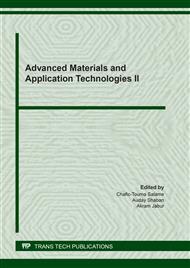[1]
M.H. Cohen, H. Fritzsche, S.P. Ovshlnsky, Simple Band Model for Amorphous Semiconducting Alloys, Phy. Rev Latter, 22 (1969): 1065.
DOI: 10.1103/physrevlett.22.1065
Google Scholar
[2]
Bahjat B. Kadhim, Ridha H. Risan, Auday H. Shaban, Kareem A. Jasim, Electrical characteristics of nickel/ epoxy - Unsaturated polyester blend nanocomposites, AIP Conf. Proc. 1968 (2019):020062-(1-5).
DOI: 10.1063/1.5116989
Google Scholar
[3]
Haider M.J. Haider, Kareem A. Jasim, Effect of Composition and Dielectric Properties for (YBCO) Superconductor Compound in Different Preparation Methods, Ibn Al-Haitham Jour. for Pure & Appl. Sci. 33(1) (2020): 17-30.
DOI: 10.30526/33.1.2372
Google Scholar
[4]
Mott, N. F.; Davis, E. A. Electronic Processes in Non-Crystalline Materials. Clarednon Press. Oxford (1979): 591.
Google Scholar
[5]
Kareem A. Jasim, Rihab Nassr Fadhil, Auday H. Shaban, Harith I. Jaafar, Bushra K.H. Maiyaly, Suad H. Aleabi, Ebtisam M-T. Salman, The effects of copper additives on the glass transition temperature and hardness for epoxy resin, PIE, Progress in Industrial Ecology – An International Journal, 13(2) (2019): 163-172.
DOI: 10.1504/pie.2019.099357
Google Scholar
[6]
A.S. Khomane. (Crystallographic and microscopic properties of ternary CdS0.5Se0.5 thin filmsR), 124(16), (2013): 2432-2435.
DOI: 10.1016/j.ijleo.2012.07.024
Google Scholar
[7]
A.S. Hassanien, Alaa A. Ak, (Effect of Se addition on optical and electrical properties of chalcogenide CdSSe thin films), Superlattices and Microstructures V.89. (2016): 153-169.
DOI: 10.1016/j.spmi.2015.10.044
Google Scholar
[8]
M. Kastner, D. Adler and H. Frizsche, Valence-Alternation Model for Localized Gap States in Lone-Pair Semiconductors, Phys. Rev. letter, 37 (1976): (1905).
DOI: 10.1103/physrevlett.37.1504
Google Scholar
[9]
Ovshinsky, S.R., Structure and Excitation of Amorphous Solids, edited by G. Lucovsky and F.L. Galeener (New York: AIP), pp (1976): 31.
Google Scholar
[10]
M.A. Paesler, Compositional dependence of the electronic properties of amorphous Te-Tl, phys. Rev. B 13 (1976): 5578.
DOI: 10.1103/physrevb.13.5578
Google Scholar
[11]
M. A. Alvi1 and Zishan H Khan, Synthesis and characterization of nanoparticle thin films of a-(PbSe) 100−xCdx lead chalcogenides, Nanoscale Research Letters 8, 148 (2013): 1-10. https://doi.org/10.1186/1556-276X-8-148.
DOI: 10.1186/1556-276x-8-148
Google Scholar
[12]
Khan ZH, Salah N, Habib S, Electrical transport of a-Se87Te13 nanorods, J Experimental Nanoscience, 6 (2011):337.
Google Scholar
[13]
Indra Sen Ram, Sunil Kumar, Rajesh Kumar Singh, Prabhakar Singh, and Kedar Singh, Electrical conduction mechanism in Se90-xTe5Sn5Inx (x = 0, 3, 6 and 9) multi-component glassy alloys, AIP Advances 5, (2015): 087164-(1-7).
DOI: 10.1063/1.4929577
Google Scholar
[14]
Haider M. J. Haider, Kassim M. Wadi, Hind A. Mahdi, Kareem A. Jasim, Auday H. Shaban, Studying the partial substitution of barium with cadmium oxide and its effect on the electrical and structural properties of HgBa2Ca2Cu3O8+δ superconducting compound, AIP Conf. Proc., 1968 (2019): 020033-(1-7).
DOI: 10.1063/1.5116960
Google Scholar
[15]
Harith I. Jaafar, Seenaa I. Hussein, Huda M. jaafar, Study of Thermal Conductivity and Solution Absorption for Epoxy –Talc Composites, Iraqi journal of science, 58(4B) (2017): 2107-2111.
DOI: 10.24996/ijs.2017.58.4b.14
Google Scholar
[16]
Mohd. Nasir, M. Zulfequar, DC Conductivity and Dielectric Behaviour of Glassy Se100–xZnx Alloy, Open Journal of Inorganic Non-metallic Materials, 2, (2012): 11-17.
DOI: 10.4236/ojinm.2012.22002
Google Scholar
[17]
Y.K. Liu, J.A. Zapien, Y.Y. Shan, C.Y. Geng, C.S. Lee, S.T. Lee, Wavelength‐Controlled Lasing in ZnxCd1–xS Single‐Crystal Nanoribbons, Adv. Mater. 17(11) (2005): 1372-1377. https://doi.org/10.1002/adma.200401606.
DOI: 10.1002/adma.200401606
Google Scholar
[18]
T.D. Rani, K. Tamilarasan, E. Elangovan, S. Leela, K. Ramamurthi, K. Thangaraj, C. Himcinschi, I. Trenkmann, S. SchuIze, M. Hietschold, A. Liebig, G. Salvan, D.R.T. Zahn, Structural and optical studies on Nd doped ZnO thin films, Superlattices and Microstructures, 77 (2015): 325-332.
DOI: 10.1016/j.spmi.2014.10.001
Google Scholar
[19]
S. K. Tripathi, R. Arora and A. Kumar, Effect of In Impurity on the Electrical Properties of Amorphous Se80Te20, Jap. J. Appl. Phys. 29(I)(2) (1990): 226. https://doi.org/10.1143/JJAP.29.226.
Google Scholar
[20]
Kareem Ali Jasim, Effect of Composition and Hydrogenated of the Density of State of Amorphous Chalcogide Semiconductor, MSc. Thesis college of Science, University of Baghdad, Iraq, (1992).
Google Scholar
[21]
Aqeel N. Abdulateef, Ahlam Alsudani, Riyadh Kamil Chillab, Kareem A. Jasim, Auday H. Shaban, Calculating the Mechanisms of Electrical Conductivity and Energy Density of States for Se85Te10Sn5-xInx Glasses Materials, Journal of Green Engineering (JGE), 10(9), (2020): 5487–5503.
Google Scholar
[22]
A.R. Jabur, B2223 High Temperature Superconductor wires in silver sheath, Filament diameter effect on critical temperature and current density, Energy Procedia 18, (2012): 254-264.
DOI: 10.1016/j.egypro.2012.05.037
Google Scholar
[23]
Nyaga, P.K. Optoelectrical and stability characterization of. SnxSey/ZnO:Sn solar cell prepared by resistive evaporation. MSc Thesis, Department of Physics. Kenyatta University, Kenya, (2014).
Google Scholar
[24]
Phillips, J. C., Phys. Rev. B. Constraint theory and carrier-type reversal in Bi-Ge chalcogenide alloy glasses, Physical Review B (Condensed Matter), 36(8) (1987): 4265-4270. 10.1103/PhysRevB.36.4265.
DOI: 10.1103/physrevb.36.4265
Google Scholar
[25]
Juejun Hu, Xiaochen Sun, Anuradha M. Agarwal,a Jean-Francois Viens, and Lionel C. Kimerling, Studies on structural, electrical, and optical properties of Cu doped As–Se–Te chalcogenide glasses, Journal of Applied Physics 101 (2007): 063520-(1-9).
DOI: 10.1063/1.2712162
Google Scholar


